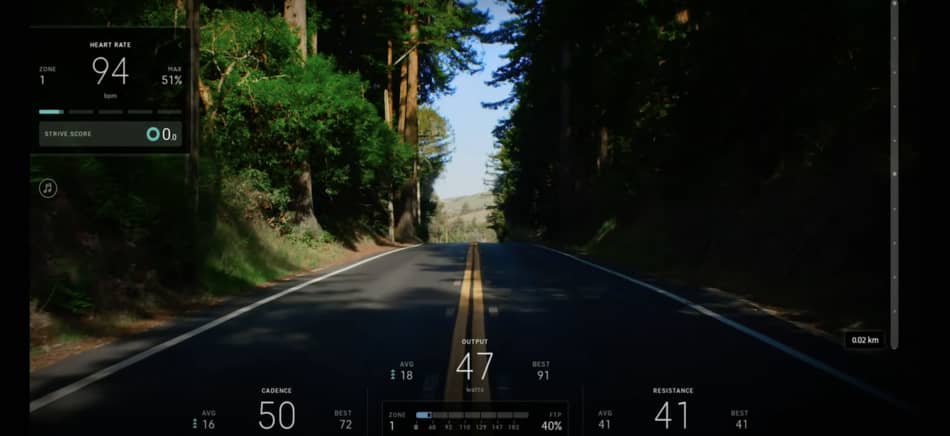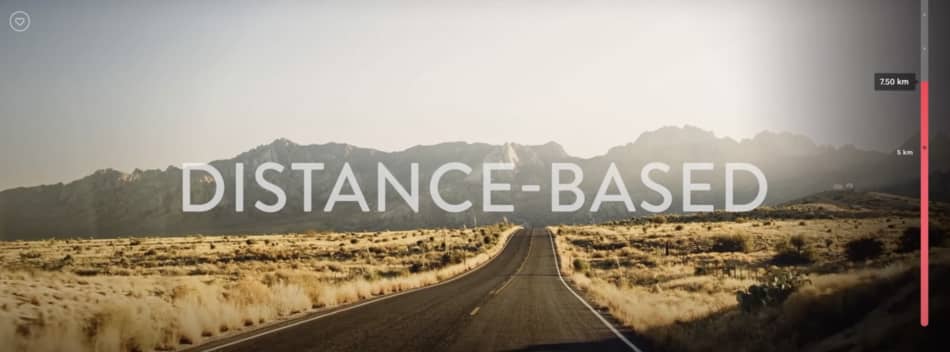
Peloton scenic rides and runs are filmed using various shot types, depending on the class you select. Time and distance-based scenic rides primarily feature point-of-view shots, while guided rides incorporate a mix of close-up, long, and medium shots.
The initial 2018 version of Peloton’s scenic rides and runs had epic locations but low-quality video playback. However, in May 2021, Peloton added and updated new scenic ride experiences shot with aerial footage, high-angle shots, and vertical camera movements. Now, there’s not only more ride variety to choose from but also a completely new filming style.
How do they film the Peloton Scenic Rides?
Peloton films scenic rides using multiple cinematic drone shots, backlit shots, and car camera shots that frame the rider from multiple angles and distances. These include tracking shots, bird’s-eye view shots, and over-the-shoulder shots. This not only makes it look more dynamic but also more realistic to ride.
What I like about the new Peloton scenic rides is that not only do you get to feel like riding along with the person, but also get to see the location from a panoramic view. If I’m being honest, I was licking my chops after I saw the new Peloton guided scenic wokrouts and the quality of how they’ve been filmed.
Peloton has three different scenic ride categories:
- Peloton Time-based Scenic Rides
- Peloton Distance-based Scenic Rides
- Peloton Guided Scenic Rides

How do they shoot the Peloton Time-Based Scenic Rides?
Peloton shoots time-based scenic rides using point-of-view shots. This works by placing the camera near the rider’s head and showing everything that the instructors are seeing in front. Peloton time-based scenic rides are the classic scenery rides that you can see in most of the cardio machines. The idea is to set a certain time and ride the bike ride within a certain timeframe
I love to see the point-of-view shots, however, when the whole class is filmed using only one perspective, it becomes boring. One thing that I like about the time-based scenic rides is there is no talking from the instructors. In general, I like the personality of the peloton trainers and I enjoy listening to them.
However, sometimes I also like to launch the time-based scenic ride and put on my music. Like John Foley, the former CEO of Peloton said “Peloton scenic content is a virtual and mental escape“.
How do they shoot the Peloton Distance-Based Scenic Rides?
Peloton distance-based scenic rides are all filmed from the first-person perspective. This means you see everything that the character (the rider) is looking at. These rides are filmed from the car using a mounted camera stabilizer, also called a gimbal. Distance-based scenic ride is a brand new class category that Peloton launched. It works by pre-selecting the distance in miles for bike and tread.
The camera stabilizer helps maintain the camera’s stability, even during rapid movements and sudden position changes. This results in smooth-motion shots. But that’s not all because one cool thing about distance-based scenic rides is that your cadence determines how fast the video will play. The faster you cycle, the faster the content moves along.

This makes the whole experience more realistic because everything that you see matches your current speed. You see, the scenery rides have been there for over a decade in all modern cardio machines like treadmills, bikes, and ellipticals. However, the speed of the content was the same, regardless of your speed or intensity. The content in peloton distance-based scenic rides matches your bike. This means that even if you stop, the video will stop.
How do they shoot the Peloton Guided Scenic Rides?
Peloton film guided scenic rides using multiple cinematic techniques like aerial shots, over-the-shoulder shots, bird’s-eye views, long shots, and first-person shots. This makes it more entertaining, as well as more attractive to participate in. Peloton-guided scenic rides are the most cinematic and engaging workouts from all scenic classes. They not only include peloton instructors in their rides but also mix footage from multiple shots.

The following list shows 8 filming techniques used in Peloton guided scenic rides.
- Medium shot: Medium shots cover the peloton instructors in close distance either just above or just below the waist (e.g. introduction talk and/or stretching at the end).
- Long shot: The frame covers the entire person in either front, back, or side (e.g. see the picture above). This is the most popular shot but it’s been used with different camera angles on both rides and runs.
- High-Angle Shots: Shooting from above eye level to make subjects seem smaller or less significant.
- Bird’s-eye view: The bird’s-eye view covers both scenery and the peloton instructor riding the bike (or running) from the elevated view. This shot is used to emphasize the epic locations (e.g. mountains or canyons) that the person is passing by.
- Jump Cut: A sudden, jarring transition between two shots.
- Point-of-view shot: Point-of-view shot is mainly used to show what the instructor is seeing in front of them. There are way more first-person shots in the peloton rides compared to peloton runs.
- Aerial shots: The aerial shots (also known as overhead shots) are taken from an elevated vantage point using an airborne device and they capture the scenery. They are mainly used as establishing shots where the viewer is introduced to the scenery.
- Rack Focus: Shifting focus between subjects in the foreground and background.
What I love the most about the new Peloton scenic rides is their aerial shots using drones because they show off some of the top locations like Hawaii, New Mexico, or Big Sur. They are also used as a way to transition from one type of scenery to another. I noticed that the Peloton filmmaking crew used many aerial shots as a way to transition from one song to another.
How do they shoot the Peloton Scenic Runs?
Peloton Scenic Runs are filmed using a combination of advanced cinematography techniques to create immersive and visually captivating content. Drone shots are employed to capture expansive aerial views of the landscapes, providing dynamic perspectives. Steadicam and dolly shots are used for smooth, stabilized footage that follows the path seamlessly, enhancing the realism of the run. Tracking shots are also used to follow the running path stably and continuously. These methods collectively contribute to the engaging and realistic experience of Peloton Scenic Runs.
How are the Peloton Scenic Rides filmed differently from in-person classes?
Peloton Scenic Rides are filmed using techniques like drone shots, Steadicam, and tracking shots to capture expansive, dynamic outdoor landscapes. In contrast, Peloton in-person classes are filmed in a studio setting with static cameras focused on the instructor and the class, emphasizing interaction and instruction.
Where do they film Peloton Live Classes?
Peloton Live Classes are filmed at the Peloton studios in New York City and London.
What is the difference between Peloton Scenic Rides and Life Fitness Lifescape?
The difference between the Peloton scenic rides and the Life Fitness Lifescape is that Life Fitness content is filmed in only one point-of-view shot. It also has the same speed throughout the whole session, regardless of your speed on the bike. This makes it very boring to do the classes because not only do you see the same places, but you also are stuck in just one camera position. On the other hand, the peloton scenic rides have three separate class categories with over 8 different kinds of shots (including different camera angles).
What is the difference between Peloton Scenic Rides and iFit Scenic Rides?
The Peloton scenic rides and iFit scenic rides are completely different but they have something in common; they both provide outdoor experience to at-home indoor cycling classes. The NordicTrack scenic rides are filmed using the first person shot throughout the whole class. However, the filming was made by the actual riders so the content feels more realistic.
One thing I love about the iFit is that they have hundreds of different scenic rides and other classes. A lot of iFit classes like pilates, strength, yoga, and cycling were shot in exotic locations like Bermuda, Bolivia, Aruba, Mexico, or Cape Town. They also show the whole map with your current position and how long you have left. On the other hand, the peloton includes a lot of different filming shots, but they present the class like an experience, rather than the class to ride along.

I’m not buying all this. Many Peloton scenic rides show pedestrians coming toward the camera, and I have yet to see any of them look at it. The camera viewpoint is several feet above the on-coming pedestrians. Why wouldn’t they look? Additionally, several of the rides end up on trails that no car can drive, so narrow and rough, in fact, that they would be difficult to mountain bike.
Sometimes the pedestrians do point or wave to the camera.
I know, that hilarious!